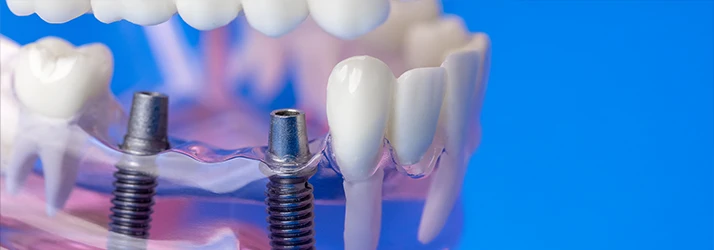Dental Bridges

Losing a tooth isn’t just a cosmetic issue—it can affect everything from how you chew to how confident you feel in social situations. At Gentle Dental, we offer dental bridges in Topsham ME, Biddeford ME, and South Portland ME as a simple, reliable solution to replace missing teeth and restore both function and appearance.
If you’ve been avoiding smiling or struggling to eat your favorite foods, a bridge might be just what you need to bring balance back to your bite—and your life.
What Is a Dental Bridge?
A dental bridge is a fixed prosthetic device that literally "bridges the gap" left by one or more missing teeth. They are used to fill the gap in a smile left by missing teeth that were lost to trauma, health conditions, or wear and tear. Dental bridges are not only a cosmetic fix, but are also used to restore a person’s ability to chew and speak correctly as well as maintain the shape of their face. Dental bridges can also keep remaining teeth from drifting out of position and becoming crooked. Bridges are highly customized and usually made from gold, alloys, or porcelain. They are anchored in place by the natural teeth on either side of the gap or by dental implants, depending on your situation.
The bridge itself consists of:
- Pontic – The artificial tooth (or teeth) that fills the gap
- Abutments – The crowns placed on neighboring teeth (or implants) that support the bridge
The result? A natural-looking, long-lasting replacement that blends seamlessly with your existing teeth.
Why Replace a Missing Tooth?
A missing tooth might seem like a minor inconvenience—until it isn’t. Even a single gap can lead to:
- Shifting of surrounding teeth
- Bite misalignment and jaw discomfort
- Difficulty chewing and speaking clearly
- Bone loss in the jaw over time
- Loss of facial structure or “sunken” appearance
- Reduced self-confidence
Dental bridges offer a strong, aesthetically pleasing way to prevent those issues and restore full functionality to your mouth.
What Is The Process of Getting Dental Bridges?
Dental bridges require several trips to the dentist in order for it to be done properly. On your first visit, the dentist will prepare the anchor teeth, or the teeth that the bridge will be anchored by. This process involves removing enamel from these teeth so that a crown can be placed on them. Impressions of your teeth will then be made so a dental lab can create the bridge custom to your mouth. You will then be given a temporary bridge to have in between bridges in order to protect the anchor teeth and gums. During your second appointment, the temporary bridge will be replaced with the custom permanent bridge. Following this appointment, you should be sure to get checkups regularly to ensure that the bridge is fitting properly and it has fixed your bite and your smile.
Types of Dental Bridges We Offer
No two mouths are the same, so we offer several types of bridges to match your specific needs:
Traditional Bridges
These are the most common type and are supported by crowns placed on natural teeth on both sides of the gap.Cantilever Bridges
Used when there’s only one adjacent tooth to support the bridge. Less common but still effective in the right cases.Maryland Bridges
Also called resin-bonded bridges, these are ideal for replacing front teeth and use metal or porcelain wings bonded to the back of nearby teeth.Implant-Supported Bridges
For those missing multiple teeth, this type uses dental implants for support instead of natural teeth, offering superior stability and longevity.
We’ll walk you through the pros and cons of each option and help you choose what’s best for your oral health and lifestyle.
What to Expect During the Dental Bridge Process
Getting a dental bridge typically involves two to three visits:
- Consultation & Evaluation
We’ll start by assessing your oral health, taking digital X-rays, and determining the best type of bridge for you. - Tooth Preparation & Impressions
If using natural teeth for support, we’ll gently reshape them and take impressions to send to our dental lab. You’ll receive a temporary bridge to wear in the meantime. - Bridge Placement
Once your permanent bridge is ready, we’ll fit it, make necessary adjustments, and cement it into place. The result? A stable, comfortable, natural-looking smile.
How Long Do Dental Bridges Last?
With good care, a dental bridge can last 10 to 15 years or more. The key is maintaining strong oral hygiene habits and attending regular dental checkups so we can monitor the health of the surrounding teeth and gums.
Tips on Dental Bridges
- Dental bridges generally last 5 to 15 years, but can last for longer if taken care of properly. Good oral hygiene and regular visits to the dentist are important to make sure your dental bridge can last for as long as possible.
- The cost of dental bridges vary depending on the size of the bridge and what your dental insurance covers. For more information about cost, contact Gentle Dental or your insurance provider!
- After your dental bridge is put in place, be sure to chew carefully and eat soft foods at first while you get used to your new bite. Once accustomed to your dental bridge, chewing and eating should become much easier!
- It is important to keep up your at-home oral care after getting dental bridges. Be sure to brush and floss regularly, and eat a balanced, nutritious diet!
Caring for Your Dental Bridge
Want to get the most out of your new smile? Here’s how to take care of your bridge:
- Brush twice daily with fluoride toothpaste
- Floss daily, especially under the bridge (we’ll show you how)
- Use a water flosser for easy cleaning
- Avoid chewing hard foods like ice or hard candy
- Keep up with dental visits for cleanings and exams
The better your care routine, the longer your bridge will last—and the healthier your smile will stay.
A Stronger, More Confident Smile Starts Here
At Gentle Dental, we know how much a complete smile can boost your confidence, comfort, and quality of life. Dental bridges are a trusted, time-tested solution that can restore what’s missing—both in your mouth and in your self-esteem.
Ready to close the gap? Contact us today to schedule your consultation and take the first step toward a stronger, more complete smile.
OUR LOCATIONS:
Topsham ME
Biddeford ME
South Portland ME
